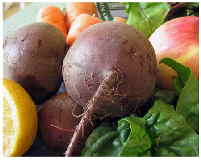
Fruit, Veggie and Vineyard Caps
Most people are chronically lacking in fruits and vegetables in the diet.
Statistics tell us that Americans are chronically lacking in fruits and vegetables in their diet. According to the USDA (in a 1999 survey), the number one vegetable eaten was potatoes (which is essentially starch) and the number two consumed vegetable was iceburg lettuce. These are not as desirable as the dark leafy greens, cruciferous vegetables (broccoli, bok choi, cabbage, Brussels sprouts, etc.) and deeply colored orange and yellow vegetables.
Fruits and vegetables are vital for good health and are outstanding sources of essential vitamins and minerals. In addition they provide other dietary compounds with powerful chronic disease risk reduction potential.
The American Institute for Cancer Research provided recommendations in 2002 that each person should eat minimally 9 servings per day... and 15 or more servings per day is ideal.
Only 14% of children between 9 and 12 years of age have four or more servings of vegetables and fruit a day (Heart & Stroke Foundation of Canada, 2002)
Center for Disease Control Report of 2005 Statistics:
Fruit
- Only 33 per cent of adult Americans ate fruit two or more times a day (recommendation is for nine servings per day).
- Men eat more fruit than women.
- Seniors eating more fruit than 35 to 44 year olds
- Hispanics eating more fruit than all other racial/ethnic groups
- Non-Hispanic whites eat the least amount of fruits
- College graduates eat more fruit than those with lower education levels
- People earning more than 50,000 US dollars a year eat more fruit than those earning less
- People who are neither obese nor overweight (Body Mass Index less than 25) eat the most fruit of any group
- Obese people (BMI over 30) eat the least amount of fruit.
Vegetables
- Only 27 per cent of adult Americans ate vegetables three or more times a day
- Men eat fewer vegetables than women
- Seniors eat more vegetables than 18 to 24 year olds
- Whites eat more vegetables than all other racial/ethnic groups
- Hispanics eat the least
- College graduates eat more vegetables than those with lower education levels
- People earning more than 50,000 US dollars a year eat more vegetables than those earning less, and
- People who are neither obese nor overweight (BMI under 25) eat the most
- Overweight people (BMI 25 to 30) eat the least amount of vegetables.
Progressive wellness professionals all make it a point to recommend that their patients eat dark leafy greens every day. And yet, most people predominately and routinely throw out the peelings and greens tops that have the most nutrients. Finally, most people overcook their vegetables and then throw out the water which now has most of what's left of the nutrients!
Even if it is just to eat a sald each day, everyone needs to know that people who eat salads have higher serum levels of vitamins C and E, folic acid, and carotenoids, according to a large study of US adults that suggests these nutrients are well absorbed in the body from raw vegetables. - Louisiana State University Health Sciences Center report in 2006 basing their their findings on data from a federal health and nutrition survey of 17,688 US adults between 1988 and 1994.
That’s why we recommend Fruit and Veggie and Vineyard capsules to everyone. Health is determined by the food we eat... and a small, simple habit can make a big difference.
|
|

Fruit and Veggie and Vineyard Caps
 Probably every mother that has ever lived on earth has told her children to eat their fruits and vegetables? Probably every mother that has ever lived on earth has told her children to eat their fruits and vegetables?
And probably every kid that ever lived has answered his/her mother, “Oh Mom, they don’t taste good!”?
So, here’s the next best thing! — Eat them in capsule form.
Our Veggie and Fruit Capsules (and our new Vineyard Blend Capsules that are shown below) provide significant amounts of carefully dehydrated vegetables, fruits and berries in capsule form (an equivalent of one-eighth of a pound of fresh fruits, berries and vegetables per 4 capsules).
(Most vegetables and fruits contain between 85% to 96% water. So, removing the water allows shrinking the space occupied until that the equivalent of many pounds of vegetables will fit inside a small bottle of capsules.)
Question: Are these fruit, berry and vineyard blend capsules a Vitamin Supplement?
Answer: No. They are whole foods - in a convenient form.
Question: How are they made?
We use a slow drying technique (using warmth instead of heat) so that the fruit and vegetable nutrients are essentially as bioavailable as were the fresh foods.
Fruit, Veggie & Vineyard Caps Ordering Form
|
Item #
 |
Description
 |
Retail Price
 |
Your Price
 |
Qty
 |
 |
| 375 |
Fruit & Veggie Caps - One Bottle Each of Each(60 capsules per bottle) |
$53.00 |
$48.00 |
|
|
| 376 |
Vineyard Caps - One Bottle (60 capsules) |
$39.00 |
$34.00 |
|
|
Money Back Guarantee of Satisfaction on All Products.
|
View Cart
|
|
|
|
Our Veggie capsules contain:
|
And our Fruit capsules contain:
|
And our Vineyard Blend capsules contain:
|
|
|
- Carrot
- Parsley
- Beet
- Kale
- Broccoli
- Cabbage
- Spinach
- Tomato
- Garlic
- Oat Bran
|
- Apple
- Orange
- Pineapple
- Cranberry
- Peach
- Cherry
- Strawberry
- Papaya
|
- Blueberry
- Elderberry
- Cranberry
- Blackberry
- Black Currant
- Concord Grape
- Bilberry
- Red Currant
- Raspberry
|
Even Uncle Sam is urging you to eat fruits and vegetables.
 The American Heart Association, the U.S. Department of Agriculture and the American Cancer Society have all done research that says your mother was right and that you need at five to ten servings of fruits and vegetables a day? The American Heart Association, the U.S. Department of Agriculture and the American Cancer Society have all done research that says your mother was right and that you need at five to ten servings of fruits and vegetables a day?
Yet almost no one follows the government’s or our mother’s astute advice. As a result we have no protection from disease and aging, the very things that fruits and vegetables save us from.
Our Fruit and Veggie Caps contain 17 different fruits and vegetables, encapsulated via a process that uses no damaging heat, making available to you literally thousands of micro nutrients that nature has packed in fruits and vegetables.
Statistics show that most people are not eating fruits and vegetables regularly like they should, but now you can. Two convenient capsules of veggie caps and two of fruit caps will make your mother happy because your body will be healthier as a result.
How To Take Fruit, Veggie and Vineyard Caps
We recommend taking two capsules of the Fruit Caps in the morning with a full glass of liquid and two caps of the Veggie Caps in the afternoon and two caps of the Vineyard Caps in the evening. They may be taken with or without other food.
Most of today’s children are eating a diet that will eventually destroy their health - but not those kids that eat 9 or more servings of fruits and vegetables each day.
Do You Realize That Most Children Are Nutritionally Under Fed And Simultaneously Calorie Overfed?
If someone wanted to feed his/her children a diet so bad that it would make them likely to come down with a whole host of killer diseases later in life they could do no better than to feed them what the average child eats today.
Meat and dairy are two main ingredients of today’s Standard American Diet - with all the artery-clogging triglycerides and cholesterol from the rest of that SAD diet: biscuits, chips, sweets and chocolate, white bread and convenience foods containing inordinate amounts of sugar. A huge government survey in 2000 discovered that are diets are horribly bad and found that the very things children should not be eating, they are eating virtually constantly.
For instance: in the age range four to eighteen, children are not eating sufficient fiber to cause them to use the toilet regularly even once per day. They found that children’s iron intake is 40 percent too low, as well as calcium and zinc intakes were also too little, as was magnesium - as much as 50 per cent too little. In some cases folate and vitamin A were too low and almost all kids ate too much protein. Never mind ‘five a day’, as many as three quarters hadn’t eaten any citrus fruits or green vegetables in the week of the survey. Not surprisingly, many were overweight and 10 per cent had unsafe cholesterol levels.
Does it matter? Yes - it’s a disaster. Today’s kids are beginning to develop adult diseases for the first time in our evolution and face much higher risks of a whole string of killer conditions as they grow up, including heart disease and cancer - both already at epidemic proportions. It’s made worse by the fact that eating habits developed in childhood tend to last for life.
The bottom line is that for the first time in the history of the world our children face a life that is going to be worse than their parents had, not better. It will be worse financially and in terms of health.
|

|

 Probably every mother that has ever lived on earth has told her children to eat their fruits and vegetables?
Probably every mother that has ever lived on earth has told her children to eat their fruits and vegetables?

 The American Heart Association, the U.S. Department of Agriculture and the American Cancer Society have all done research that says your mother was right and that you need at five to ten servings of fruits and vegetables a day?
The American Heart Association, the U.S. Department of Agriculture and the American Cancer Society have all done research that says your mother was right and that you need at five to ten servings of fruits and vegetables a day?